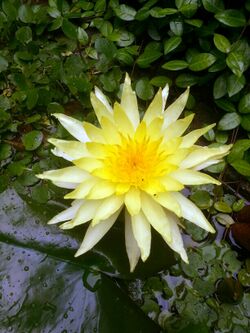Biology:Nymphaea mexicana
| Nymphaea mexicana | |
|---|---|

| |
| Scientific classification | |
| Kingdom: | Plantae |
| Clade: | Tracheophytes |
| Clade: | Angiosperms |
| Order: | Nymphaeales |
| Family: | Nymphaeaceae |
| Genus: | Nymphaea |
| Species: | N. mexicana
|
| Binomial name | |
| Nymphaea mexicana Zucc.
| |
| Synonyms[1] | |
| |
Nymphaea mexicana is a species of aquatic plant that is native to the Southern United States and Mexico as far south as Michoacán.[2][3] Common names include yellow water lily, Mexican water lily and banana water lily.
Role as invasive species
Nymphaea mexicana is perhaps best known as a noxious weed in wetlands outside of its native range, such as California . It can easily invade similar aquatic ecosystems when it is introduced. The plant is attractive and has been introduced to new habitats for ornamental purposes.[citation needed]
Description

Nymphaea mexicana has thick rhizomes and long, spongy creeping stolons which bear bunches of small yellow roots that resemble miniature bananas. The plant can grow from seedlings or send out new shoots from its stolons. The large, flat leaves are green with purple or brown patterning, and float on the surface of the water. The floating lotus flowers have yellow petals and pointed, star-like, greenish-yellow sepals. The flowers close at night.[4]

The plant flowers during the summer, and also during spring and fall in warmer areas. Seeds are contained in green berries which grow underwater. It grows in marshes and readily invades canals and other shallow waterways, sometimes becoming a nuisance.
Cytology
The chromosome count is n = 28. The genome size is 586.80 Mb.[5]
Reproduction
Vegetative reproduction
Nymphaea mexicana reproduces vegetatively through stolons. Their structure, resembling bananas, consists of leaf buds and thick, starchy roots.[6]
Ecology
Herbivory
The canvasback duck, Aythya valisineria, feeds on the banana-like roots of the plant.[7]
References
- ↑ "Nymphaea mexicana Zucc." (in en). Royal Botanic Gardens, Kew. http://www.plantsoftheworldonline.org/taxon/171199-2. Retrieved 11 January 2024.
- ↑ {{citation | mode = cs1 | title = Nymphaea mexicana | work = Germplasm Resources Information Network (GRIN) | url = | publisher = [[Organization:Agricultural Research ServAgricultural Research Service (ARS), United States Department of Agriculture (USDA) | access-date = 2010-04-19 }}
- ↑ Biota of North America Program 2014 county distribution map
- ↑ Flora of North America, Nymphaea mexicana Zuccarini, 1832. Banana water-lily, yellow water-lily, herbe au coeur
- ↑ Chen, Fei; Liu, Xing; Yu, Cuiwei; Chen, Yuchu; Tang, Haibao; Zhang, Liangsheng (2017). "Water lilies as emerging models for Darwin’s abominable mystery". Horticulture Research 4: 17051. doi:10.1038/hortres.2017.51. PMID 28979789.
- ↑ Wiersema, J. H. (1988). Reproductive Biology of Nymphaea (Nymphaeaceae). Annals of the Missouri Botanical Garden, 75(3), 795–804. https://doi.org/10.2307/2399367
- ↑ Mowbray, Thomas B. (2020-03-04). "Canvasback (Aythya valisineria)". Cornell Lab of Ornithology. http://birdsoftheworld.org/bow/species/canvas/cur/introduction.
External links
- USDA Plants Profile
- Lady Bird Johnson Wildflower Center
- California Department of Food and Agriculture
Wikidata ☰ Q748322 entry
 |

